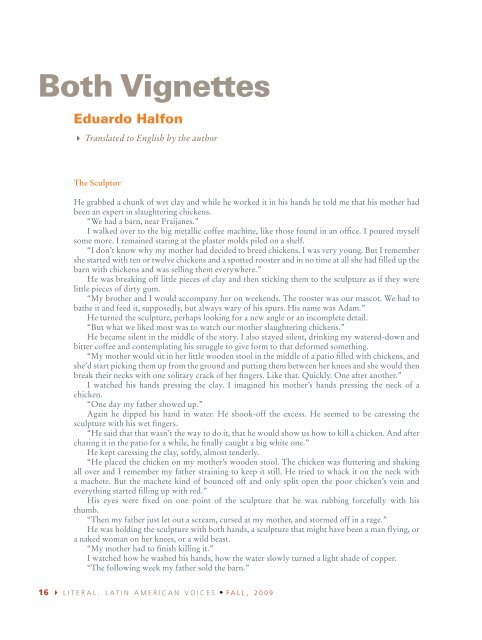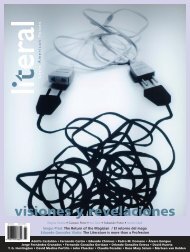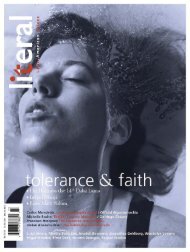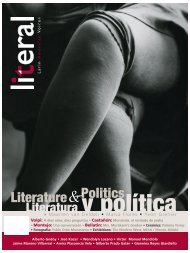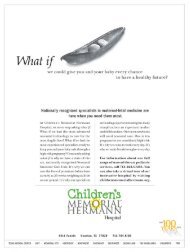Giobany Arévalo > Gabriela Torres Olivares >Anuar Jalife - Literal
Giobany Arévalo > Gabriela Torres Olivares >Anuar Jalife - Literal
Giobany Arévalo > Gabriela Torres Olivares >Anuar Jalife - Literal
You also want an ePaper? Increase the reach of your titles
YUMPU automatically turns print PDFs into web optimized ePapers that Google loves.
Both Vignettes<br />
Eduardo Halfon<br />
Translated to English by the author<br />
The Sculptor<br />
He grabbed a chunk of wet clay and while he worked it in his hands he told me that his mother had<br />
been an expert in slaughtering chickens.<br />
“We had a barn, near Fraijanes.”<br />
I walked over to the big metallic coffee machine, like those found in an offi ce. I poured myself<br />
some more. I remained staring at the plaster molds piled on a shelf.<br />
“I don’t know why my mother had decided to breed chickens. I was very young. But I remember<br />
she started with ten or twelve chickens and a spotted rooster and in no time at all she had fi lled up the<br />
barn with chickens and was selling them everywhere.”<br />
He was breaking off little pieces of clay and then sticking them to the sculpture as if they were<br />
little pieces of dirty gum.<br />
“My brother and I would accompany her on weekends. The rooster was our mascot. We had to<br />
bathe it and feed it, supposedly, but always wary of his spurs. His name was Adam.”<br />
He turned the sculpture, perhaps looking for a new angle or an incomplete detail.<br />
“But what we liked most was to watch our mother slaughtering chickens.”<br />
He became silent in the middle of the story. I also stayed silent, drinking my watered-down and<br />
bitter coffee and contemplating his struggle to give form to that deformed something.<br />
“My mother would sit in her little wooden stool in the middle of a patio fi lled with chickens, and<br />
she’d start picking them up from the ground and putting them between her knees and she would then<br />
break their necks with one solitary crack of her fi ngers. Like that. Quickly. One after another.”<br />
I watched his hands pressing the clay. I imagined his mother’s hands pressing the neck of a<br />
chicken.<br />
“One day my father showed up.”<br />
Again he dipped his hand in water. He shook-off the excess. He seemed to be caressing the<br />
sculpture with his wet fi ngers.<br />
“He said that that wasn’t the way to do it, that he would show us how to kill a chicken. And after<br />
chasing it in the patio for a while, he fi nally caught a big white one.”<br />
He kept caressing the clay, softly, almost tenderly.<br />
“He placed the chicken on my mother’s wooden stool. The chicken was fl uttering and shaking<br />
all over and I remember my father straining to keep it still. He tried to whack it on the neck with<br />
a machete. But the machete kind of bounced off and only split open the poor chicken’s vein and<br />
everything started fi lling up with red.”<br />
His eyes were fi xed on one point of the sculpture that he was rubbing forcefully with his<br />
thumb.<br />
“Then my father just let out a scream, cursed at my mother, and stormed off in a rage.”<br />
He was holding the sculpture with both hands, a sculpture that might have been a man fl ying, or<br />
a naked woman on her knees, or a wild beast.<br />
“My mother had to fi nish killing it.”<br />
I watched how he washed his hands, how the water slowly turned a light shade of copper.<br />
“The following week my father sold the barn.”<br />
16 LITERAL. LATIN AMERICAN VOICES FALL, 2009


